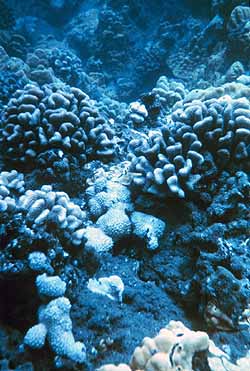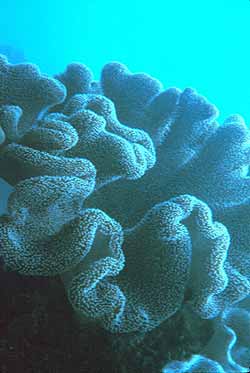
 Coral Reefs
Coral Reefs
Coral are extremely ancient animals that evolved into reef-building forms over the last 25 million years. Coral reefs are among the most biologically diverse regions on Earth. Only tropical rainforests might provide homes for more species of plant and animal life. Even though they cover only a tiny fraction (less than .2 percent) of the ocean's bottom, coral reefs contain more than 25 percent of all marine life.
Photo: Coral
assemblage.
Photo courtesy of NOAA/Department of Commerce and Dr. James P. MCVey.
There are two main types of coral: hard coral, the major reef-building species; and soft coral, such as sea whips and sea fans. Like the tropical rainforests, coral reefs are normally found in the tropical and semitropical areas of the world where water temperatures range between 16 and 30 degrees Celsius (61 and 86 degrees Fahrenheit). However, there are some coral in the North Atlantic termed cold water coral, but they are a fraction of the coral throughout the ocean. The optimal temperature for coral usually occurs within 30 degrees latitude of the equator.
Although coral reefs have been around for millions of years, the reefs we see today resulted from production that occurred over the past 5,000 to 10,000 years. The actual coral make up only a small part of the life found on the reefs, but the reefs provide habitat for numerous other species. Tropical waters that are warm, clear, low in nutrients (like phosphorous and nitrogen), and have a stable temperature and salinity (salt content), are ideal for reef development.
Coral reefs are classified into three types: barrier reefs, fringing reefs, and atolls. Barrier reefs occur offshore separated by water from the mainland. Fringing reefs are continuous with the land mass, and atolls are islands made of coral surrounding a central lagoon.
For a long time coral were a mystery. They were called a plantanimal, animal plant, and rock plant. We now know that coral are a complex mix of animal and plant life with microscopic forms of plants called algae living within the coral. The type of algae that lives within the coral are called zooxanthellae. The small animals that make up coral are called polyps.
Most coral are colonial; that is, coral are made up of many individual polyps connected by living tissue. Each polyp has a cuplike shape with a ring of tentacles around a central opening. The tentacles are tipped with stinging cells used for defense and to capture zooplankton (small animal life) for food. The tiny polyps are the actual living coral tissue. The coral consist of polyps that secrete a substance called limestone. (The chemical name for limestone is calcium carbonate.) The limestone forms an exoskeleton, which is similar to our skeleton or a snail's shell. The coral reefs grow from this limestone.
Only the uppermost layer of a coral reef contains living polyps. As new layers of the coral reef are built, the polyps with their algae depart from the lower layers, leaving behind another layer of the reef structure.
Not all coral produce reefs. Those that do are called hermatypic.
 The small zooxanthellae algae perform photosynthesis, using light energy to convert water and carbon dioxide into food. Although coral polyps are carnivorous, they receive much of their energy from this photosynthesis. In return, the algae have a safe place to live within the coral tissue, and the algae use the coral's wastes for growth. This type of arrangement, where organisms live together and benefit, is called symbiosis. When both organisms benefit, it is known as a mutualistic symbiosis.
The small zooxanthellae algae perform photosynthesis, using light energy to convert water and carbon dioxide into food. Although coral polyps are carnivorous, they receive much of their energy from this photosynthesis. In return, the algae have a safe place to live within the coral tissue, and the algae use the coral's wastes for growth. This type of arrangement, where organisms live together and benefit, is called symbiosis. When both organisms benefit, it is known as a mutualistic symbiosis.
Although limestone-secreting species exist that do not have a symbiotic relationship with the zooxanthellae, these species do not build reefs. Photo: Feeding polyps. Photo courtesy of NOAA/Department of Commerce and Dr. James P. MCVey.
Fairly recently, scientists realized that reefs have many benefits. Because of this, many countries began to better manage their coastal areas in order to protect and restore reefs. In recent years some deterioration of known coral reefs has been noted. Some experts suggest that 10 percent of Earth’s coral reefs have already been destroyed and that another 60 percent are in danger. Not everyone agrees. One researcher thinks the problem has been exaggerated because only reefs close to population centers have been thoroughly observed. Some causes of the destruction are obvious—fishermen who dynamite and inject cyanide poison into reefs, for example. Other causes, however, are uncertain. Some result from human activity, some are natural, and some have uncertain sources.
The question then arises: Even if coral reefs are being destroyed at an alarming rate, why should we be concerned?
We know that coral reefs provide a food source and a living for many people, especially in developing nations, such as the Philippines and the Dominican Republic. Anti-cancer drugs and painkillers have been developed from coral reef products. Research is now being done on a method to encourage bone growth in humans, similar to how the coral secrete limestone. Additionally, coral reefs play an important role in biogeochemical cycles, especially the carbon cycle.
Glossary ..|.. Related Links ..|.. References |..PBL Model
Home ..|.. Teacher Pages ..|.. Modules & Activities
Maintained by ETE Team
Last updated
March 09, 2004
Privacy Statement and Copyright © 1997-2004 by Wheeling Jesuit University/NASA-supported Classroom of the Future. All rights reserved.
Exploring the Environment®, Coral Reefs was developed under a cooperative agreement with NASA.
Some images © 2004 www.clipart.com
Center for Educational Technologies, Circuit Board/Apple graphic logo, and COTF Classroom of the Future logo are registered trademarks of Wheeling Jesuit University.